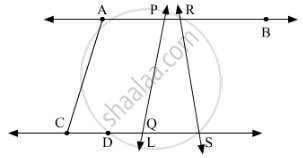Advertisements
Advertisements
Question
In the below fig., name the following:

(i) five line segments.
(ii) Five rays.
(iii) Four collinear points.
(iv) Two pairs of non-intersecting line segments.
Solution
(i) A line segment is a part of line defined by two end points. So in the given figure 7.17, five line segments are:

(1) AC
(2) CD
(3) AP
(4) PQ
(5) RS
(ii) A ray is the part of line with one end point and one end which can be extended. So in the given figure 7.17, five rays are:
(1) Ray RB
(2) Ray RS
(3) Ray PQ
(4) Ray DS
(5) Ray AB
(iii) Collinear points are the points which are present on the same line. In the present figure 7.17, there are two sets of four collinear points.
(1) A, P, R, B
(2) C, D, Q, S
(iv) In the given figure 7.17, two pairs of non intersecting line segments are:
(1) AB and CS
(2) AC and PQ
APPEARS IN
RELATED QUESTIONS
Define the following term :
Collinear points
Define the following terms :
Parallel lines
Define the following term
Concurrent lines
Write the truth value (T/F) of each of the following statements
A segment has no length.
Write the truth value (T/F) of each of the following statements
Every ray has a finite length.
Write the truth value (T/F) of each of the following statements:
A ray has one end-point only.
Write the truth value (T/F) of each of the following statements
The ray AB is same as ray BA.
Write the truth value (T/F) of each of the following statement:
Only a single line may pass through a given point.
Write the truth value (T/F) of each of the following statements:
Two lines are coincident if they have only one point in common.
Fill in the blank so as to make the following statement
A line separates a plane into parts namely the and the itself.
